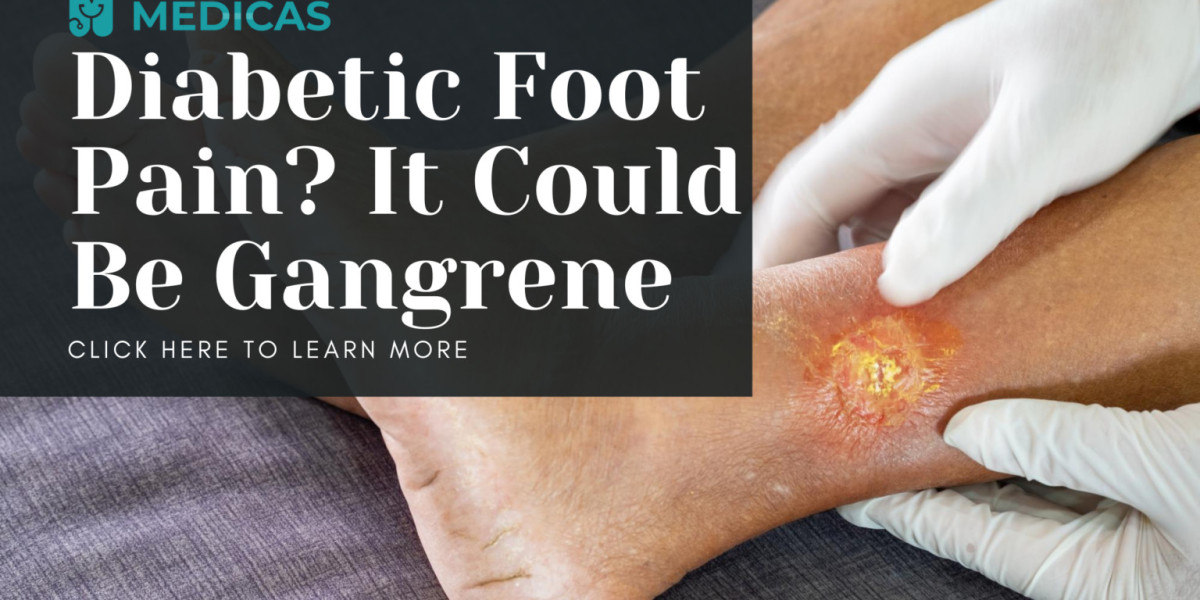Introduction
Gangrene is a serious condition that occurs when body tissue dies due to a lack of blood flow or a severe bacterial infection. In individuals with diabetes, the risk of developing gangrene is significantly higher due to complications like poor circulation and nerve damage. This article explores the causes, symptoms, prevention, and treatment of gangrene in diabetes.
What is Gangrene?
Gangrene refers to the death of body tissues due to a lack of blood supply or infection. It commonly affects the extremities, such as fingers, toes, and limbs, but can also occur in muscles and internal organs. In people with diabetes, the risk is heightened because of complications like peripheral artery disease (PAD) and diabetic neuropathy.
Types of Gangrene
Gangrene can manifest in different forms, primarily categorized into two main types: dry gangrene and wet gangrene. Each type has distinct characteristics and underlying causes, affecting the approach to treatment and management.
Dry Gangrene
Dry gangrene occurs when blood flow to a particular area of the body is restricted, usually due to poor circulation. This lack of blood supply causes the tissue to dry out, leading to a gradual death of the affected area. The skin may appear black or brown, and the area often becomes dry and shriveled. This type of gangrene progresses slowly and is more common in individuals with diabetes or conditions that affect blood vessels.
Wet Gangrene
Wet gangrene, on the other hand, is characterized by a bacterial infection that rapidly infects the tissues. This type typically develops in areas where blood flow is compromised, leading to an accumulation of fluid and a moist appearance. The affected area may appear swollen, blistered, and have a foul odor. Wet gangrene can spread quickly and is considered a medical emergency, requiring immediate treatment to prevent life-threatening complications.
Causes of Gangrene in Diabetes
Gangrene in diabetes arises from a combination of factors that compromise blood flow and the body's ability to fight infections. Understanding these causes is crucial for prevention and management.
Poor Blood Circulation
Diabetes can lead to poor blood circulation due to the narrowing of blood vessels, a condition known as peripheral artery disease (PAD). This narrowing restricts the flow of oxygen-rich blood to the limbs, increasing the risk of tissue death. Reduced blood flow makes it challenging for the body to deliver essential nutrients and immune cells to injured areas, making them more susceptible to gangrene.
Nerve Damage
Diabetic neuropathy, a common complication of diabetes, involves damage to the nerves that can result in a loss of sensation, particularly in the extremities. This loss of feeling can make it difficult for individuals to notice injuries, cuts, or ulcers on their feet or toes. Without the ability to feel pain or discomfort, these injuries can go untreated, allowing infections to develop and worsen, ultimately leading to gangrene.
Infection
High blood sugar levels associated with diabetes can weaken the immune system, making it less effective at fighting off infections. This compromised immune response means that even minor injuries can become severe infections if not promptly treated. Bacterial infections can quickly spread in diabetic individuals, especially in areas with poor circulation, creating an environment where gangrene can develop rapidly.
Symptoms of Gangrene
Gangrene presents with various symptoms, indicating the severity and progression of tissue death. Recognizing these symptoms early can be crucial for timely medical intervention.
Discoloration
One of the most noticeable symptoms of gangrene is discoloration of the affected area. The skin may turn black, blue, or green, depending on the type and severity of the gangrene. This color change occurs due to the lack of blood flow and subsequent tissue death, which can cause a dark, necrotic appearance.
Swelling and Blisters
In cases of wet gangrene, the affected area may become swollen and blistered. This occurs because the bacterial infection causes a buildup of fluid and gas within the tissues. The blisters may burst, releasing a foul-smelling discharge. The presence of swelling and blisters is a sign of rapid tissue decay and requires immediate medical attention.
Foul Odor
A strong, unpleasant odor is often associated with gangrene, especially wet gangrene. This foul smell results from the decay of dead tissue and the presence of bacterial infections. The odor can be quite pronounced and is a critical indicator that the tissue is decomposing.
Pain or Numbness
Gangrene can cause varying sensations in the affected area, ranging from pain to complete numbness. In dry gangrene, the tissue may become numb due to nerve damage and lack of blood flow. In wet gangrene, pain may be severe due to the infection and swelling. Numbness may also occur as the nerves become damaged or destroyed by the progression of the disease.
Prevention of Gangrene in Diabetes
Blood Sugar Control: Maintaining optimal blood sugar levels is crucial in preventing complications.
Foot Care: Regular inspection and proper care of feet can prevent infections.
Healthy Lifestyle: A balanced diet, regular exercise, and avoiding smoking can improve circulation.
Regular Check-ups: Regular medical check-ups can help detect early signs of complications.
Treatment Options for Gangrene
1. Medications
Antibiotics: Used to treat bacterial infections.
Pain Relievers: To manage pain and discomfort.
2. Surgical Procedures
Debridement: Removal of dead tissue to prevent the spread of infection.
Amputation: In severe cases, the removal of affected limbs may be necessary.
3. Other Treatments
Hyperbaric Oxygen Therapy: Involves breathing pure oxygen in a pressurized room, which can help heal wounds.
4. Lifestyle Changes
Diet and Exercise: A balanced diet and regular exercise can improve overall health and circulation.
FAQs about Gangrene in Diabetic
Q1: What are the early signs of gangrene?
A1: Early signs include changes in skin color, swelling, and a foul odor.
Q2: Can gangrene be cured?
A2: Early treatment can manage the condition, but severe cases may require amputation.
Q3: Is gangrene in diabetes preventable?
A3: Yes, proper blood sugar management, foot care, and a healthy lifestyle can help prevent it.
Q4: How quickly can gangrene develop?
A4: Wet gangrene can develop rapidly, often within hours, while dry gangrene progresses more slowly.
Q5: What should I do if I suspect gangrene?
A5: Seek immediate medical attention. Early intervention is crucial.
Conclusion
Gangrene in diabetes is a serious condition that requires prompt medical attention. Understanding its causes, symptoms, and preventive measures can help manage the risks associated with diabetes. By maintaining good blood sugar control, taking care of your feet, and living a healthy lifestyle, you can significantly reduce the chances of developing gangrene. Always consult a healthcare professional if you suspect any symptoms or complications.








